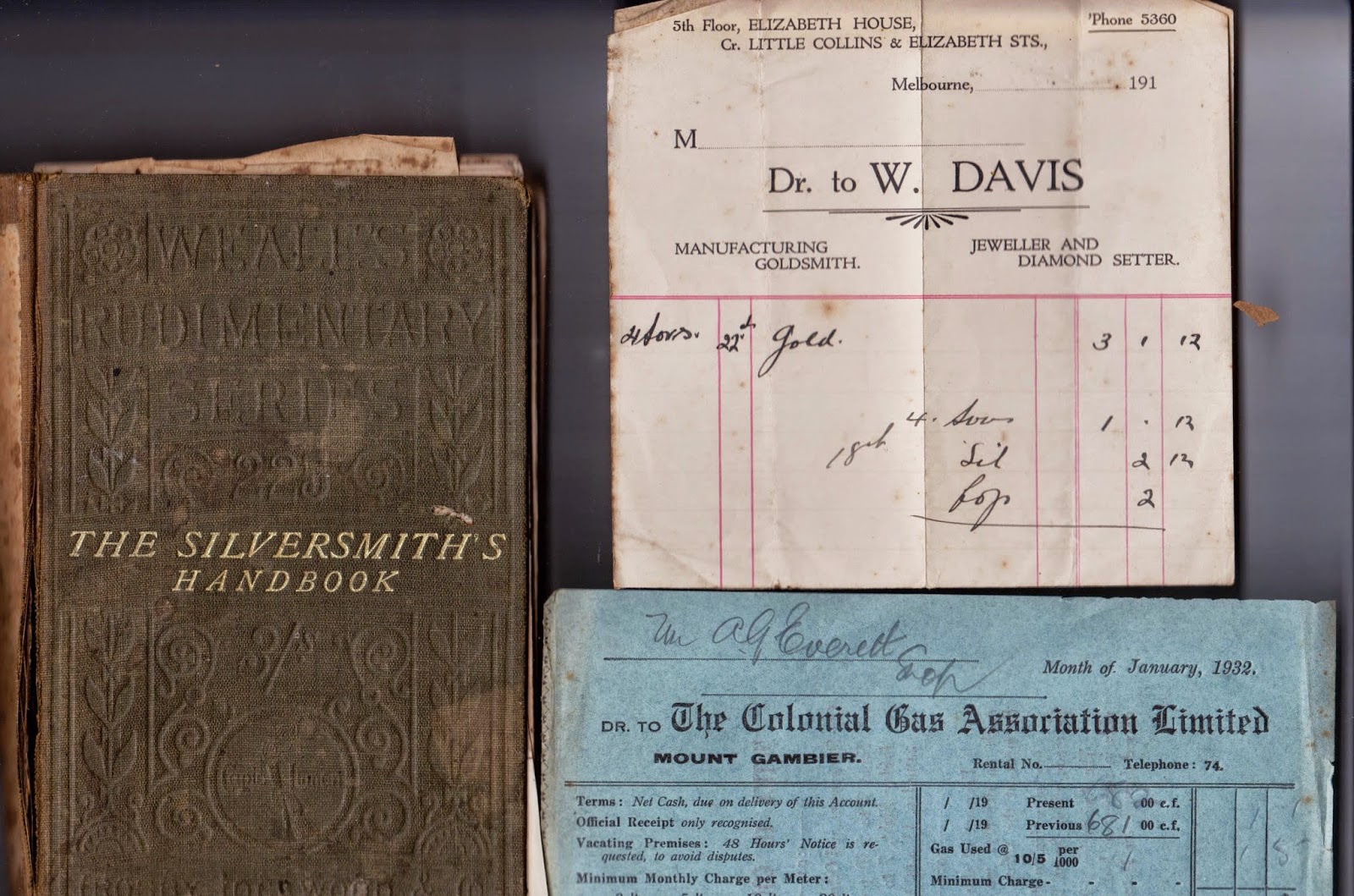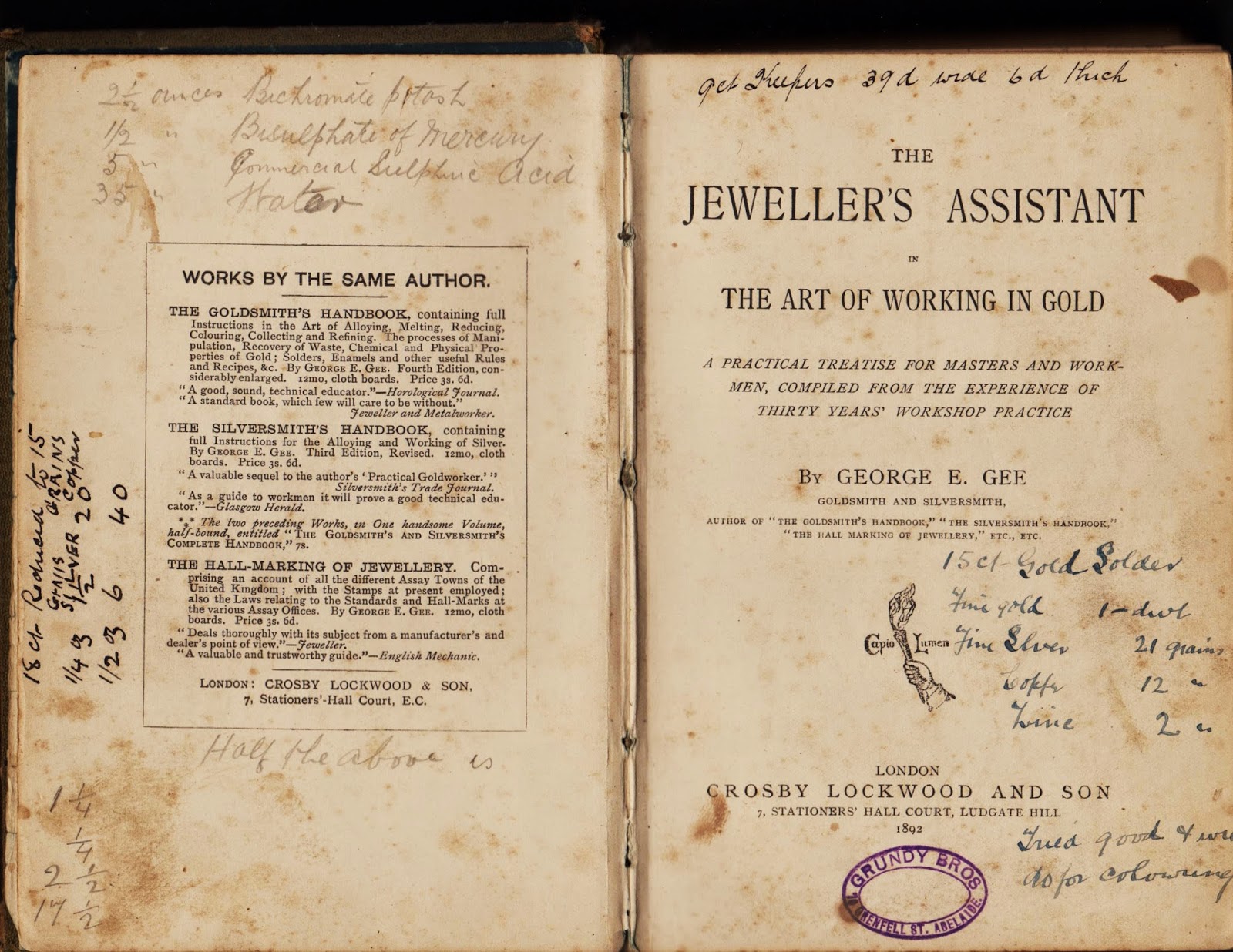Forsaking the opportunity to
celebrate Easter and consume
or give eggs
made from child
slave cocoa, Cyclops went
hunting oddities
in garage sales
. Obsessed by
books and ephemera , he
stumbled across a veritable pirate’s
treasure trove of
gold sovereigns , silver , gold bars and gemstones , with links to
early Australian jewellers . All this from
one box of books , some volumes broken , attacked by worm , sunned , foxed , the remains of a wasp nest
attached to one .
Of particular
interest
were two 1890s books
which had obviously belonged
to a person or persons involved
in the precious
metals and jewellery trade .
In the above
1892 volume ,The Jeweller’s Assistant in the Art of Working in Gold , by George. E. Gee , were two
interesting inserts and
several trade stamps .
An account , which appears
to be for setting
gold sovereigns , circa
1916 , was from the Melbourne firm of
W . Davis . William Davis was
a founding
member of the Manufacturing Jewellers’ Association
of Victoria , formed in 1889, his
mark being a Leopard’s head .
According to the W. Davis & Son website , gold and silver dealers, the seventh oldest remaining jewellery business in Australia , William
Davis first set up shop in 119 Chapel Street, Windsor, in 1880,
transferred to 137 Chapel Street in 1882
and to 114 Elisabeth Street , Melbourne, in 1892. He was then trading as a
jeweller , diamond setter and gold
chain maker . By 1916 , the business
was located in 340 Little Collins Street .
The
second document , a
January 1932 bill –three shillings (30 cents ) - from the
Mount Gambier , South Australia , office of The Colonial Gas Association Limited, is for
a
shop run by a
Mr A. G. Everitt .
Alfred George Everitt , a jeweller with a colourful background
in Victoria , had died a month later
. An obituary in the Mount Gambier newspaper , The Border Watch
said he had been resident in the
town for 47 years , having been born at South Yarra ,
Victoria, 71 years ago. After
following his father
in the bookbinding
trading , he had been apprenticed
to the "celebrated Bourke Street jeweller, " Mr
T. Gaunt . At the time , Gaunt was
making railway station and town
hall clocks , Mount Gambier’s Town Hall clock one of them .
Everitt later
joined the firm of Stevenson Bros
. , another prominent Adelaide jeweller , with spectacular window displays and a large gold clock outside in Rundle Street from which people checked their watches . Everitt then moved to Mount
Gambier, where he opened a jeweller's shop in Caledonian House. A few years
later, he moved further down the
street to a shop occupied until he died .
It appears
that the 1892 book almost certainly belonged to Everitt
as it includes the Everitt
trade stamp on many pages , along with extensive
handwritten notes , in ink and
pencil, about alloys , gold
solder , other aspects of the jewellery trade. The title page bears the
stamp of Grundy Bros., Grenfell Street, Adelaide , a
wholesale jeweller and general
importer, which made a submission to the
Tariff Commission in 1905,when it was stated that there about
150 working jewellers in South Australia .
During the hearing it was said
that working out the involved tariff
on imported jewellery , if applied
to the importer
of toys , would send him
to a lunatic
asylum . The famous Adelaide firm of
Wendt’s, which made
spectacular pieces of colonial silver ,
also made a submission . Grundy Bros was taken over in
1928 and became
Dean and Keen , jewellers and opticians .
There was also a copy of 1967 book, The Australian Amateur Lapidary by K. J. Buchester , with a loosely inserted 1966 price list for lapidary supplies from E. Tinsley , Bourke Street Melbourne , and a sheet for the Robilt grinding and polishing machine .
There was also a copy of 1967 book, The Australian Amateur Lapidary by K. J. Buchester , with a loosely inserted 1966 price list for lapidary supplies from E. Tinsley , Bourke Street Melbourne , and a sheet for the Robilt grinding and polishing machine .





